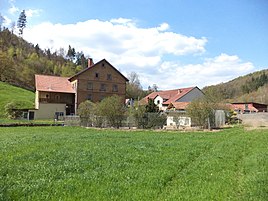Horror mill
|
Schreckemühle
Schreckemühle Community Schollbrunn
Coordinates: 49 ° 49 ′ 52 ″ N , 9 ° 29 ′ 13 ″ E
|
|
|---|---|
| Height : | 212 m above sea level NHN |
|
The two main buildings of the Schrecke (n) mill
|
|
Schreckenmühle (also Schreckemühle ) is a wasteland in the municipality of Schollbrunn in the Lower Franconian district of Main-Spessart in Bavaria . The Haslochbach flows through the wilderness and flows into the Main in Hasloch .
location
The mill is located in a single location on the western slope side in the middle Haslochtal (Haseltal) east of the main community Schollbrunn in Spessart . The Michelriether Forest with the Reinstein Castle Stables lies to the east across the Hasloch . The Zwieselmühle is located north upstream , and the Nickelsmühle is located south-east downstream .
history
The mill was first mentioned indirectly in a document in 1328 and 1595. Your name comes from an operator called Schreck . In 1629 it is mentioned as being owned by the Grünau Charterhouse . Around 1700 the newer mill is built by the Triefenstein Monastery , which leads to legal disputes between the two monasteries over the property.
The Wiesmann family has been known as the tenant of one, and later both, mills since the middle of the 18th century . In 1773 they could not hold the second mill. Until 1803 the mill was still owned by the Grünau monastery . Between 1805 and 1820, the mills were reunited in the hands of the Wiesmann family and in their possession. Around 1854 the old Bachmühlen were abandoned and replaced by a water wheel located in the building.
Around 1882 the mill building was rebuilt or rebuilt in its current form. It was modernized as an art mill by 1889 . 1910 with a steam engine for low water continued to improve, done in 1936, a mill conversion with new roller mills and plan sifter and the replacement of the water wheel through a turbine and 1948 further modernization. In 1961 a restaurant was opened in the mill.
In 1983 a new turbine was installed and from 1986 the water power was used again to generate electricity (two-chamber flow turbine ). Another profound modernization of the last still active grinding and grain mill in Haslochtal took place at the end of the 1980s / beginning of the 1990s through a major renovation: almost complete automation (control of the grinding via a central switchgear (PLC control)) and capacity expansion (new indoor silo ), new plansifters and new roller mills as well as conversion of all machines to individual drives.
Others
As a mill, the horror mill has its own trademark. On the building there is a boundary stone of the " Mühlguht " from 1879. The mill consists of two buildings with separate house numbers and is part of the European cultural route Mühlenstraße Haseltal .
A few dozen meters at the mill dam of the Haslochbach along the hiking trail over the Holländerbrücke to the Nickelsmühle , below a spring outlet from the direction of Schollbrunn, there is the so-called Maria-Hilf-wayside shrine and a Christian memorial stone. A statue of the Virgin Mary is placed at the source outlet itself.
Web links
- Schreckemühle , private website of the mill
- Location of Schreckenmühle on the BayernAtlas
Individual evidence
- ^ Schreckenmühle in the local database of the Bayerische Landesbibliothek Online . Bayerische Staatsbibliothek, accessed on July 31, 2017.
- ↑ a b c d e Chronicle of the Schreckemühle , private website of the mill; accessed on June 20, 2018
- ↑ a b c d Schreckemühle - The last miller in the valley (= information board at the Schreckenmühle), website of the Spessart project; accessed on June 20, 2018
- ↑ Haseltal: Mühlenstraße Haseltal , European cultural route of the Spessart project


